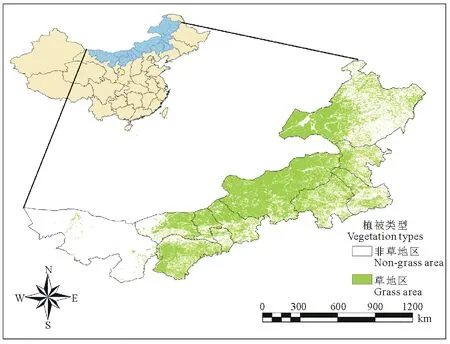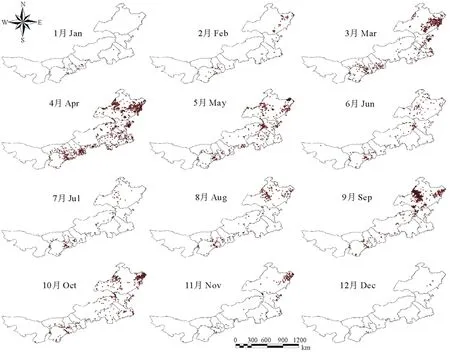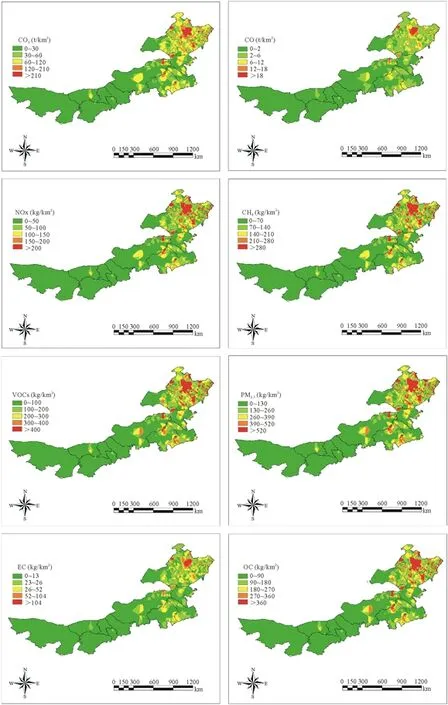2005-2014年内蒙古草地火灾排放污染物的时空格局
2017-02-28靳全锋鞠园华杨夏捷王文辉郭福涛
靳全锋,鞠园华,杨夏捷,王文辉,郭福涛*
(1.福建农林大学林学院, 福建 福州 350002;2.福建农林大学海峡两岸水土保持协同创新中心,福建 福州 350002)
2005-2014年内蒙古草地火灾排放污染物的时空格局
靳全锋1,2,鞠园华1,2,杨夏捷1,2,王文辉1,2,郭福涛1,2*
(1.福建农林大学林学院, 福建 福州 350002;2.福建农林大学海峡两岸水土保持协同创新中心,福建 福州 350002)
火是生态系统重要干扰因子并对大气环境和人类健康有显著影响。该研究基于2005-2014年内蒙古地区MODIS遥感卫星火点数据,结合畜牧业统计年鉴,估算各区域草地火燃烧生物量,运用排放因子法、核密度法和克里金插值法,估算10年间内蒙古地区草原排放污染物总量及时空分布。研究结果显示,内蒙古地区草地生物质密度存在显著差异,由东北到西南呈递减趋势。此外,内蒙古地区草地火时空分布不均匀:草地火年变化呈阶梯式上升趋势,月变化呈双峰分布,火灾多集中3-4月和9-10月;空间上,火点密度从东北向西南逐渐递减。呼伦贝尔、兴安盟、通辽、赤峰、锡林郭勒盟、乌兰察布、包头、呼和浩特、巴彦淖尔、鄂尔多斯、乌海和阿拉善盟分别占区域总火灾次数的48.1%、7.4%、2.8%、1.9%、8.3%、3.8%、4.3%、1.2%、1.0%、20.6%、0.3%和0.3%。内蒙古地区草地火灾排放污染物CO2、CO、NOX、CH4、VOCS、PM2.5、OC和EC总量分别为:658.31 kt、39.09 kt、846.18 t、1.22 kt、1.87 kt、2.49 kt、1.65 kt和197.96 t。此外,各污染物排放在时间和空间上不均衡,且与草地火密度的时空分布密切相关。该文通过对内蒙古地区草原火释放污染物的时空变化研究,为深入揭示草原火对区域环境的影响提供数据支持。
内蒙古;草地火;污染物;时空分布
火是生态系统重要干扰因子,生物质燃烧释放大量污染对全球大气环境、气候变化和生态系统有显著影响。全球有6800 Tg[1](1979)、8680 Tg[2](1990)和8600 Tg[3](2001)生物质被燃烧,研究显示每年有2000 Tg C来源生物质火灾,其中52%来源于非洲,30%来源美洲,14%来源亚洲,其他区域仅占4%[4-5]。全球有3488 Mhm2的草业资源,草地火灾是最大的生物质燃烧源[6-7]。草地火灾释放大量污染性气体(CO2、CO、CH4、NOx、SO2、VOCs、烃和卤代物等)和颗粒物(TSP、PM10、PM2.5、PM1、OC、EC和气溶胶等)显著影响空气质量和人类健康[7-9]。CO2、CH4和N2O是导致气候变暖的主要因素[10-11],卤代物是破坏臭氧层的元凶[12],SO2、NOx、OC和EC促进光化学烟雾形成,降低能见度[13],此外,草地火不仅破坏生态系统,同时降低土壤质量,造成水土流失[14-15]。目前关于草地火灾污染物排放研究已展开,随着科学技术发展,利用卫星遥感数据对草地火灾烟气排放检测已成为主流方法[16-18]。
中国是居世界第二的草地资源大国,草地占国土面积的2/5,也是草地火灾频发的国家,每年有1/3的草地遭受火灾的破坏[39]。由于人类活动导致草地火频发,95%草地火由人类活动引起[19]。目前我国已开展草地火灾研究,并取得一定进展[18,20-24],但以往研究主要存在以下问题,(1)研究以草地火险等级划分为主[20-22,24],(2)研究草地火灾影响因子[18-23]。此外,峰芝等[25]对内蒙古草地火灾的研究表明,大面积、高强度火灾排放到大气中的污染更多,而内蒙古草地火灾具有面积大、强度高等特性,这极大增加了探讨内蒙古草地火灾对大气环境影响的意义。然而,目前关于内蒙古草地火灾发生特点的研究还较少,尤其关于草地火灾的烟气排放问题更是鲜有报道。
鉴于此,本文综合国内外文献及中国畜牧业年鉴[26]对内蒙古地区过去10年间的草地火灾排放污染物的时空格局进行分析。主要研究目标为: 1)估测出2005-2014年内蒙古地区草地火灾时空分布。2)估算内蒙古各区域草地燃烧导致的各类污染物的排放总量。3)分析内蒙古草地火排放各类污染物的空间分布。本研究可为相关大气模型研究和大气环境污染评价提供科学依据。
1 材料与方法
本研究以内蒙古草地为研究区域,根据排放因子及各区域草地火灾面积,估测内蒙古地区2005-2014年草地火灾释放CO2、CO、NOx、CH4、VOCs、PM2.5、OC和EC等污染物的总量及时空变化。
1.1 研究区概况
内蒙古地区位于中国北部(图1),地理范围是北纬37°24′-53°23′,东经97°12′-126°04′,东与黑龙江、吉林和辽宁三省接壤,西到甘肃,南与河北、山西和宁夏相邻,北与蒙古和俄罗斯比邻,东西跨度约2400 km,南北相距约1700 km。该区域由九市三盟组成,为温带大陆性季风气候,年降水量50~450 mm,年平均气温0~8 ℃,季节降水不均匀,春季温热干旱,夏季炎热多雨,秋季温和少雨,寒冬降水量较少。内蒙古地区的草原从东北向西南具有明显的地带性分布,分别是温带草甸草原、温带典型草原、温带荒漠草原等植被类型,区域面积1.18×105km2,占中国国土面积12.3%,草地面积7.88×104km2,草地占区域面积的66.78%[23]。

图1 内蒙古草地空间分布Fig.1 Spatial distribution of grassland in Inner Mongolia
1.2 数据来源
2005-2014年草地火灾面积数据来源于中国畜牧业年鉴[26],每年草地火面积的平均值为该火点面积;2005-2014年内蒙古草地火数据来源于MODIS(Moderate Resolution Imaging Spectrometer)1 km空间分辨率的每日尺度MOD14A1林火产品,提取2005-2014年内蒙古地区林火像素数据,MODIS林火产品在监测植被火灾方面具有良好的可靠性[27],目前MODIS火点受自然因素影响,成功监测率为90%左右,但通过滤除噪声、耀斑及云的干扰,不同区域和季节林火成功监测率高达100%[28]。研究提取了2005-2014年内蒙古地区卫星火点数据与植被类型图(1 km空间分辨率)进行叠加(http://westdc.westgis.ac.cn/),提取草原火点数据,数据包含了每个火点地理坐标、时间和植被类型。内蒙古草地生物质密度运用陈效逑等[29]内蒙古典型草原地上生物量的空间格局及其气候成因分析和Ma等[19]估算内蒙古温带草地生物量及其与环境因子的关系共同估算内蒙古草地生物质密度的空间分布,Kato等[30]草原燃烧效率采样为96%。
1.3 排放因子的确定
排放因子是精确估测各类排放物总量的重要前提。本文综合国内外学者研究成果,目前关于国内草地火灾的排放因子的实测数据较少,本研究选用国外与中国国情相似草地燃烧的排放因子,同时对众多研究结果取平均值作为本研究的排放因子(表1)。

表1 草排放因子Table 1 Emission factors from grassland fire g/kg
1.4 草地燃烧量计算
草地燃烧用公式(1)进行计算[31]
Mi=A×B×EFi×η
(1)
式中,Mi为i类污染物的排放总量,kg;A为草地火灾过火面积,hm2;B为单位面积草原生物量密度,t/hm2;EFi为i类污染物的排放因子,g/kg;η为草地的燃烧效率。
1.5 数据处理
利用Excel统计2005-2014年每次草地火发生时间、位置和面积,以获取草地火时空分布特征,根据草地火点及污染物空间分布特征运用ARCGIS软件的核密度法和克里金插值法绘制草原火密度和污染物空间分布图。
2 结果与讨论
2.1 内蒙古草地生物质密度和草原火点空间分布格局
图2a显示内蒙古地区草地生物质密度空间分布不均匀,生物质密度从东北向西南逐渐递减。内蒙古草地生物质密度主要受降水、温度、相对湿度、纬度和经度等因子影响。研究表明内蒙古区域平均降水量为250~450 mm,且呈东南向西北递减趋势分布,即随着经度增加而增加,温度随着纬度增加而降低;内蒙古区域草地生物质密度与降水、湿度和经度呈正相关,与温度和干燥度呈负相关[29-35]。
2005-2014年内蒙古草地区域发生12904次,年均1290次草地火点,火点在空间分布不均匀,运用ArcGIS 10.0绘制火点密度如图2b,火点密度分布规律具有从东北向西南逐渐递减。呼伦贝尔、兴安盟、通辽、赤峰、锡林郭勒盟、乌兰察布、包头、呼和浩特、巴彦淖尔、鄂尔多斯、乌海和阿拉善盟分别占区域草地火48.1%、7.4%、2.8%、1.9%、8.3%、3.8%、4.3%、1.2%、1.0%、20.6%、0.3%和0.3%.该研究年均卫星火点与峰芝等[25]研究一致,由于草地火受自然因素(气温、降水、相对湿度等)、人为因素(放牧数量、道路密度、农田等)和生物质特性等因素影响。相关研究表明生物质密度越大、温度越高、降水越少、相对湿度越低、放牧数量越少、距道路越近越有利于草地火灾发生[21-23]。

图2 2005-2014年内蒙古地区草地生物质密度和草原火密度空间分布Fig.2 Spatial distribution of biomass density and grassland fire density in Inner Mongolia during 2005-2014
2.2 内蒙古草地火点时间分布格局

图3 2005-2014年内蒙古地区草地火点年变化Fig.3 Temporal change grassland fire in Inner Mongolia during 2005-2014

图4 2005-2014年内蒙古地区草地火点时空分布Fig.4 Temporal change grassland fire in Inner Mongolia during 2005-2014
图3显示2005-2014年内蒙古地区草地火年变化呈阶梯式上升趋势。该研究与周怀林等[21]研究较为相似;草地火的年际变化受气候条件、植被性质和人类活动等因子影响,降水、光照和温度是草地生态系统的重要影响因子。研究表明内蒙古地区年均增温0.034 ℃,内蒙古地区降水从东北向西南逐渐降低,有利于内蒙古东部区域草地生物质的积累,降低西部区域生物质积累[36]。气候条件的变化、生物量积累加速及人类活动频繁等因子共同作用促进草地火灾频发[37-38]。
图4显示内蒙古草地火的月际变化不均匀,火点比率呈双峰分布,主峰显著高于次峰, 3-5月和9-10月是草地火多发期,分别占据全年火点总量的50%和29%。该研究与周怀林等[21]研究一致,草地火集中在春、秋两季主要受自然因素(降水、空气湿度、温度和风速等)、草地植被性质和植被含水率等因素影响。张正祥等[24]研究表明内蒙古草地区域春季降水较少、相对湿度低、气温回暖快、风速较大导致植被含水量低,前一年死亡生物质较多,极易促进草地火灾形成;秋季内蒙古草地区域生物质大量死亡、降水较少、空气湿度降低和风速较强有利于草地火灾的形成,但由于气温下降较快降低火频率,导致春季火灾频率显著高于秋季;其他月份由于降水、温度和草地属性等因子阻碍草地火发生。

图5 2005-2014年内蒙古草地火灾排放污染物总量空间分布Fig.5 Spatial distribution of the total emissions of pollutants from grassland burned in Inner Mongolia during 2005-2014
2.3 内蒙古草地火排放污染物的空间分布格局
内蒙古草地火排放受内、外因素共同作用而不断发生变化,运用大量静态数据,并不能反映草地火排放动态变化,估算污染物排放通过改变计算方式逐渐逼近真实值,不可能成为真实值,以往研究表明运用平均值是减少误差的常用估算方法。估算草地火污染物排放量分别运用草地火每年平均面积、生物质密度和平均排放因子等共同估算污染物排放总量,如图5显示各区域污染物排放总量差异很大,各污染物分布有所不同,2005-2014年中国内蒙古地区草地火灾排放污染物CO2、CO、NOx、CH4、VOCs、PM2.5、OC和EC总量分别为:619.43 kt、36.78 kt、796.20 t、1.15 kt、1.76 kt、2.34 kt、1.55 kt和186.27 t,年均排放量分别为:61.94 kt、3.68 kt、79.62 t、114.68 t、176.41 t、234.11 t、154.86 t和18.63 kt;呼伦贝尔由于草地火灾产生污染物总量为550.83 kt,主要污染物CO2、CO、NOx、CH4、VOCs、PM2.5、OC和EC总量分别为:480.59 kt、28.53 kt、617.74 t、889.77 t、1.37 kt、1.82 kt、1.20 kt和144.52 t;兴安盟、通辽、赤峰、锡林郭勒盟、乌兰察布、包头、呼和浩特、巴彦卓、鄂尔多斯、乌海和阿拉善盟区域草地火灾释放污染物总量分别为:45.80 kt、14.63 kt、12.91 kt、38.46 kt、3.65 kt、14.11 kt、2.86 kt、2.39 kt、13.18 kt、298.49 t和546.27 t;CO2、CO、NOx、CH4、VOCs、PM2.5、OC和EC等污染物排放分别在各区域占比为93.29%、5.54%、0.12%、0.17%、0.27%、0.35%、0.23%和0.03%;根据空气质量标准将污染物划分为5个等级,单位面积内草地火排放污染物如图5所示。由图5可知单位面积最大污染物浓度是CO2> CO > PM2.5> EC >VOCs >OC >CH4>NOx,且污染浓度最大区域集中在火密度较高区域(图2b),呼伦贝尔、兴安盟、通辽、赤峰、锡林郭勒盟等区域草地火密度较大,其他区域相对较小;污染物CO2、CO、NOx、CH4、VOCs、PM2.5、OC和EC排放高低和草地火密度有密切正相关,草地火受自然因素和社会经济因素共同影响[24]。草地是陆地生态系统重要组成部分,是生物圈中初级生产者,是牧区经济社会可持续发展的物质基础。草地火灾是牧草区域危害最大的自然灾害,草地烧毁严重威胁畜牧业发展,草地火灾可烧毁草地植被、牧民住房以及对人畜生命造成严重威胁[39];由于草地火灾频发及大量污染物排放发生造成草地植被覆盖度降低,水土流失严重导致土壤贫瘠甚至形成荒漠化造成生态环境的恶性循环[40-42]。
2.4 内蒙古草地火排放比较及不确定分析
研究表明草地火排放受生物质密度、燃烧效率、气相因子和经济社会等因素影响。本研究草地火灾资料分别来源畜牧业年鉴和MODIS卫星火点数据,具有较高可信度。在估算草地颗粒物排放时,需要引入燃烧效率系数和排放因子,而燃烧效率和排放因子受燃烧方式、自然环境等因素影响,目前国内关于该研究尚未见报,因此本研究以多种草燃烧实测数据的平均值作为本研究排放因子,增加草地火排放研究结果的可靠性,但由于国内对内蒙古草地燃烧排放因子及燃烧效率缺少试验研究,导致了本研究结论在内蒙古草地污染物排放的空间异质性方面缺少考虑,今后还需要加强草地火污染物排放的实测工作,以便充分考虑内蒙古不同草地的污染物排放特性,进一步提高草业火灾污染物排放估测的准确性。
Yan等[39]研究内蒙古地区草地火排放CO2、CO、NOx、CH4、VOCs和PM2.5分别为20.56 kt、1.10 kt、19.34 t、68.20 t、52.32 t和52.33 t,本研究与该研究结果较为接近;陆炳等[34]研究内蒙古地区生物质燃烧排放CO2、CO、NOx、CH4、VOCs和PM2.5分别为18.2 mt、1.97 mt、23.9 kt、88.7 kt、171.5 kt和96.3 kt,该研究结果是本研究的290倍,显著高于本研究。由于该研究为室内生物质燃烧排放污染物总量,而本研究仅对草地燃烧进行了估算,故研究结论有较大差异。
3 结论
本文利用卫星火点数据结合中国畜牧业年鉴并采用排放因子法,对2005-2014年间内蒙古地区草地生物质分布及草地火排放污染物CO2、CO、NOx、CH4、VOCs、PM2.5、OC和EC的总量和时空分布进行系统的研究,得到如下主要结论。
(1)内蒙古地区草地生物质密度空间分布不均匀,生物质密度从东北向西南逐渐递减。
(2)内蒙古地区草地火灾时间和空间上不均衡分布,草地火多集中在春、秋两季;2005-2014年间内蒙古地区草地火年比率的变化呈阶梯式上升趋势;火点在空间分布不均匀,火点密度分布规律具有从东北向西南逐渐递减的趋势。
(3)2005-2014年内蒙古地区草地火灾排放污染物CO2、CO、NOx、CH4、VOCs、PM2.5、OC和EC总量分别为:619.43 kt、36.78 kt、796.20 t、1.15 kt、1.76 kt、2.34 kt、1.55 kt和186.27 t,年均排放量分别为:61.94 kt、3.68 kt、79.62 t、114.68 t、176.41 t、234.11 t、154.86 t和18.63 kt;各污染物排放在时间和空间上不均衡,各污染物排放量多集中在呼伦贝尔东北和西北地区、兴安盟、通辽和锡林郭勒盟交汇处、乌兰察布东南部、呼和浩特东北地区和鄂尔多斯、巴彦淖尔和包头交汇区域等区域。
References:
[1] Crutzen P J, Heidt L E, Krasnec J P,etal. Biomass burning as a source of atmospheric gases CO, H2, N2O, NO, CH3Cl and COS. Nature, 1979, 282: 253-256.
[2] Levine J S. Global biomass burning: atmospheric, climatic and biospheres’ implications. Atmospheric Climatic & Biospheric Implications, 1991, 71(37): 1075-1077.
[3] Andreae M O, Merlet P. Emission of trace gases and aerosols from biomass burning. Global Biogeochemical Cycles, 2001, 15(4): 955-966.
[4] Penner J E, Zhang S, Ito A. Estimates of Black Carbon Emissions from Open Biomass Burning[C]. London: American Geophysical Union Fall Meeting, 2004.
[5] Van D W G R, Randerson J T, Giglio L,etal. Interannual variability of global biomass burning emissions from 1997 to 2004. Atmospheric Chemistry & Physics Discussions, 2006, 6(2): 3175-3226.
[6] Balezentiene L, Uzupis A, Mednis M. Fuzzy TOPSIS method applied for evaluation of mitigation strategies for greenhouse gas emissions from abandoned grassland. Applied Information and Communication Technologies, 2012, 75(3): 242-249.
[7] Sinha P, Hobbs P V, Yokelson R J,etal. Emissions of trace gases and particles from savanna fires in southern Africa: Safari 2000-Southern African regional science initiative. Journal of Geophysical Research, 2003, 108(D13): 315-323.
[8] Cheng Z L, Lam K S, Chan L Y,etal. Chemical characteristics of aerosols at coastal station in Hong Kong. II. Seasonal variation of major ions, halogens and mineral dusts between 1995 and 1996. Atmospheric Environment, 2000, 34(17): 2771-2783.
[9] Ma W, Yang Y, He J,etal. Above- and belowground biomass in relation to environmental factors in temperate grasslands, Inner Mongolia. Science China Life Sciences, 2008, 51(3): 263-270.
[10] Andreae M O, Atlas E, Cachier H,etal. Trace gas and aerosol emissions from savanna fires. Atmospheric Chemistry & Physics, 1996, 33(3): 271-280.
[11] Iii W R C, Levine J S, Winstead E L,etal. Source compositions of trace gases released during African savanna fires. Journal of Geophysical Research Atmospheres, 1996, 101(D19): 23597-23602.
[12] Burling I R, Yokelson R J, Griffith D W T,etal. Laboratory measurements of trace gas emissions from biomass burning of fuel types from the southeastern and southwestern United States. Atmospheric Chemistry & Physics, 2010, 10(22): 11115-11130.
[13] Fernandes A P, Alves C A, Gonçalves C,etal. Emission factors from residential combustion appliances burning Portuguese biomass fuels. Journal of Environmental Monitoring, 2011, 13(11): 3196-3206.
[14] Levine J. Influence of Biomass Burning Emissions on Precipitation Chemistry in the Equatorial Forests of Africa[M]. London: Massachusetts Institute of Technology Press, 1991: 167-173.
[15] Yokelson R J, Bertschi I T, Christian T J,etal. Trace gas measurements in nascent, aged, and cloud-processed smoke from African savanna fires by airborne Fourier transform infrared spectroscopy (AFTIR). Journal of Geophysical Research, 2003, 108(13): 267-289.
[16] Lee B S, Alexander M E, Hawkes B C,etal. Information systems in support of wildland fire management decision making in Canada. Computers & Electronics in Agriculture, 2002, 37(1): 185-198.
[17] Matthews S. A comparison of fire danger rating systems for use in forests. Australian Meteorological & Oceanographic Journal, 2009, 58(1): 41-48.
[18] Liu X P, Zhang J Q, Tong Z J. Modeling the early warning of grassland fire risk based on fuzzy logic in Xilingol, Inner Mongolia. Natural Hazards, 2015, 75(75): 2331-2342.
[19] Zhang J Q, Zhang H, Tong Z J,etal. Loss assessment and grade partition of grassland fire disaster in Northern China. Acta Prataculturae Sinica, 2007, 16(6): 121-128. 张继权, 张会, 佟志军, 等. 中国北方草原火灾灾情评价及等级划分. 草业学报, 2007, 16(6): 121-128.
[20] Li X H, Wu W J, Zhang C,etal. Influence of climate change on north-eastern of Inner Mongolia grassland forest fire. Journal of Arid Land Resources & Environment, 2011, 25(11): 114-119.
[21] Zhou H L, Wang Y H, Zhou G S. Temporal and spatial dynamics of grassland fires in Inner Mongolia. Acta Prataculturae Sinica, 2016, 25(4): 16-26. 周怀林, 王玉辉, 周广胜. 内蒙古草原火的时空动态特征研究. 草业学报, 2016, 25(4): 16-25.
[22] Li N, Bao Y L, Yin S,etal. Spatiotemporal characteristics of grassland fire in China mongolia border regions. Journal of Catastrophology, 2016, 31(3): 207-210. 丽娜, 包玉龙, 银山, 等. 中蒙边境地区草原火时空分布特征分析. 灾害学, 2016, 31(3): 207-210.
[23] Qu Y P, Zheng S X, Bai Y F. Spatiotemporal patterns and driving factors of grassland fire on Mongolian Plateau. Chinese Journal of Applied Ecology, 2010, 21(4): 807-813. 曲熠鹏, 郑淑霞, 白永飞. 蒙古高原草原火行为的时空格局与影响因子. 应用生态学报, 2010, 21(4): 807-813.
[24] Zhang Z X, Zhang H Y, Li D X,etal. Spatial distribution pattern of human-caused fires in Hulunbeir grassland. Acta Ecologica Sinica, 2013, 33(7): 2023-2031. 张正祥, 张洪岩, 李冬雪, 等. 呼伦贝尔草原人为火空间分布格局. 生态学报, 2013, 33(7): 2023-2031.
[25] Feng Z, Bao Y L, Pao Y H,etal. Analysis of spatial and temporal characteristics of fire behavior in Inner Mongolia grassland[C]. Hohhot: Risk analysis and information technology in crisis response, 2014. 峰芝, 包玉龙, 泡玉海, 等. 内蒙古牧区草原火行为时空特征分析[C]. 呼和浩特: 风险分析和危机反应中的信息技术, 2014.
[26] Yearbook Editorial Board China. Animal Husbandry Livestock Yearbook[M]. Beijing: China Agriculture Press, 2006-2015. 中国畜牧业年鉴编辑委员会. 中国畜牧业年鉴[M]. 北京: 中国农业出版社, 2006-2015.
[27] Amraoui M, Pereira M G, Dacamara C C,etal. Atmospheric conditions associated with extreme fire activity in the Western Mediterranean region. Science of the Total Environment, 2015, 524: 32-39.
[28] Zhou X C, Wang X Q. Validate and improvement on arithmetic of identifying forest fire based on EOS-MODIS data. Remote Sensing Technology & Application, 2006, 21(3): 206-211. 周小成, 汪小钦. EOS-MODIS数据林火识别算法的验证和改进. 遥感技术与应用, 2006, 21(3): 206-211.
[29] Chen X Q, Zheng T. Spatial patterns of aboveground gicmass and its climatie attributions in typical steppe of Inner Mongolia. Scientia Geographica Snica, 2008, 28(3): 369-374. 陈效逑, 郑婷. 内蒙古典型草原地上生物量的空间格局及其气候成因分析. 地理科学, 2008, 28(3): 369-374.
[30] Kato E, Kawamiya M, Kinoshita T,etal. Development of spatially explicit emission scenario from land-use change and biomass burning for the input data of climate projection. Procedia Environmental Sciences, 2011, 6(1): 146-152.
[31] Seiler W, Crutzen P J. Estimates of gross and net fluxes of carbon between the biosphere and the atmosphere from biomass burning. Climatic Change, 1980, 2(3): 207-247.
[32] Urbanski S. Wildland fire emissions, carbon, and climate: Emission factors. Forest Ecology & Management, 2014, 317(2): 51-60.
[33] Liu Y, Goodrick S, Heilman W. Wildland fire emissions, carbon, and climate: Wildfire-climate interactions. Forest Ecology & Management, 2014, 317(2): 80-96.
[34] Lu B, Kong S F, Han B,etal. Inventory of atmospheric pollutants discharged from biomass burning in China continent in 2007. China Environmental Science, 2011, 31(2): 186-194. 陆炳, 孔少飞, 韩斌, 等. 2007年中国大陆地区生物质燃烧排放污染物清单. 中国环境科学, 2011, 31(2): 186-194.
[35] Zhang H B, Tang H J, Yang G X,etal. Changes of spatial-temporal characteristics based on MODIS NDVI data in Inner Mongolia grassland from 2000 to 2008. Transactions of the Chinese Society of Agricultural Engineering, 2009, 25(9): 168-175. 张宏斌, 唐华俊, 杨桂霞, 等. 2000-2008年内蒙古草原MODIS NDVI时空特征变化. 农业工程学报, 2009, 25(9): 168-175.
[36] Zhang X Y, Hu Y F, Zhuang D F,etal. The spatial pattern and differentiation of NDVI in Mongolia Plateau. Geographical Research, 2009, 28(1): 10-18. 张雪艳, 胡云锋, 庄大方, 等. 蒙古高原NDVI的空间格局及空间分异. 地理研究, 2009, 28(1): 10-18.
[37] Guo F T, Wang G Y, Su Z W,etal. What drives forest fire in Fujian, China? Evidence from logistic regression and Random Forests. International Journal of Wildland Fire, 2016, 25: 505-519.
[38] Guo F T, Su Z W, Wang G Y,etal. Wildfire ignition in the forests of southeast China: Identifying drivers and spatial distribution to predict wildfire likelihood. Applied Geography, 2016, 66: 12-21.
[39] Yan X, Ohara T, Akimoto H. Bottom-up estimate of biomass burning in mainland China. Atmospheric Environment, 2006, 40(27): 5262-5273.
[40] Hernandez-Leal P A, Arbelo M, Gonzalez-Calvo A. Fire risk assessment using satellite data. Advances in Space Research, 2006, 37(4): 741-746.
[41] Venkataraman C, Joshi P, Sethi V,etal. Aerosol and carbon monoxide emissions from low-temperature combustion in a sawdust packed-bed stove. Aerosol Science & Technology, 2004, 3(1): 50-61.
[42] Jaiswal R K, Mukherjee S, Raju K D,etal. Forest fire risk zone mapping from satellite imagery and GIS. International Journal of Applied Earth Observation & Geoinformation, 2002, 4(1): 1-10.
Temporal and spatial patterns of emissions and pollutants from grassland burned in Inner Mongolia during 2005-2014
JIN Quan-Feng1,2, JU Yuan-Hua1,2, YANG Xia-Jie1,2, WANG Wen-Hui1,2, GUO Fu-Tao1,2*
1.FujianAgricultureandForestryUniversity,Fuzhou350002,China; 2.Co-innovationCenterforSoilandWaterConservationinRedSoilRegionoftheCross-straits,FujianAgricultureandForestryUniversity,Fuzhou350002,China
Fire is an important disturbance in ecosystems, and fires significantly affect the atmospheric environment and human health. Combining MODIS satellite data for the Inner Mongolia region during 2005-2014 and data from the Animal Husbandry Statistical Yearbook, we estimated the burnt biomass of regional grassland. The total emissions and spatial and temporal distribution of pollutants from grassland fires during 2005-2014 were also explored using emission factor, kernel density, and kriging interpolation methods. The results indicated that the density of burned grassland biomass differed within Inner Mongolia, decreasing from the northeast to the southwest parts of Inner Mongolia. The grassland fires were distributed unevenly, both spatially and temporally, in the study area. The grassland fires showed a stable annual growth and mainly occurred in March-April and September-October every year, showing two distinct peaks. Spatially, the distribution of fire point density gradually decreased from the northeast to the southwest parts of the study area. The proportions of total grassland fires in the various regions of Inner Mongolia were as follows: Hulun Buir (48.1%), Xing’an League (7.4%), Tongliao (2.8%), Chifeng (1.9%), Xilinguole (8.3%), Wulanchabu (3.8%), Baotou (4.3%), Hohhot (1.2%), Bayanzuoer (1.0%), Erdos (20.6%), Wuhai (0.3%), and Alashan (0.3%). During the period of 2005-2014, the total emissions of various substances were as follows: CO2(658.31 kt), CO (39.09 kt), NOx (846.18 t), CH4(1.22 kt), volatile organic compounds (1.87 kt), particulate matter smaller than 2.5 μm (2.49 kt), organic carbon (1.65 kt), and elemental carbon (197. 96 t). The emission of each type of pollutant varied spatially and temporally and was significantly correlated with the density distribution of fires. In this study, we explored the spatial and temporal dynamic changes in pollutants emitted from grassland fires in Inner Mongolia. This information will underpin further research on this regional environment by providing a robust database.
Inner Mongolia; grassland fire; pollutants; temporal and spatial distribution
10.11686/cyxb2016337
http://cyxb.lzu.edu.cn
2016-09-06;改回日期:2016-11-17
国家自然科学基金(31400552),福建农林大学杰出青年基金项目(xjq201613),福建省自然科学基金(2015J05049)和福建省教育厅省属高校专项(JK2014012)资助。
靳全锋(1988-),男,安徽阜阳人,在读硕士。E-mail:jinquanfeng2006@126.com
*通信作者Corresponding author. E-mail:guofutao@126.com
靳全锋, 鞠园华, 杨夏捷, 王文辉, 郭福涛. 2005-2014年内蒙古草地火灾排放污染物的时空格局. 草业学报, 2017, 26(2): 21-29.
JIN Quan-Feng, JU Yuan-Hua, YANG Xia-Jie, WANG Wen-Hui, GUO Fu-Tao. Temporal and spatial patterns of emissions and pollutants from grassland burned in Inner Mongolia during 2005-2014. Acta Prataculturae Sinica, 2017, 26(2): 21-29.
